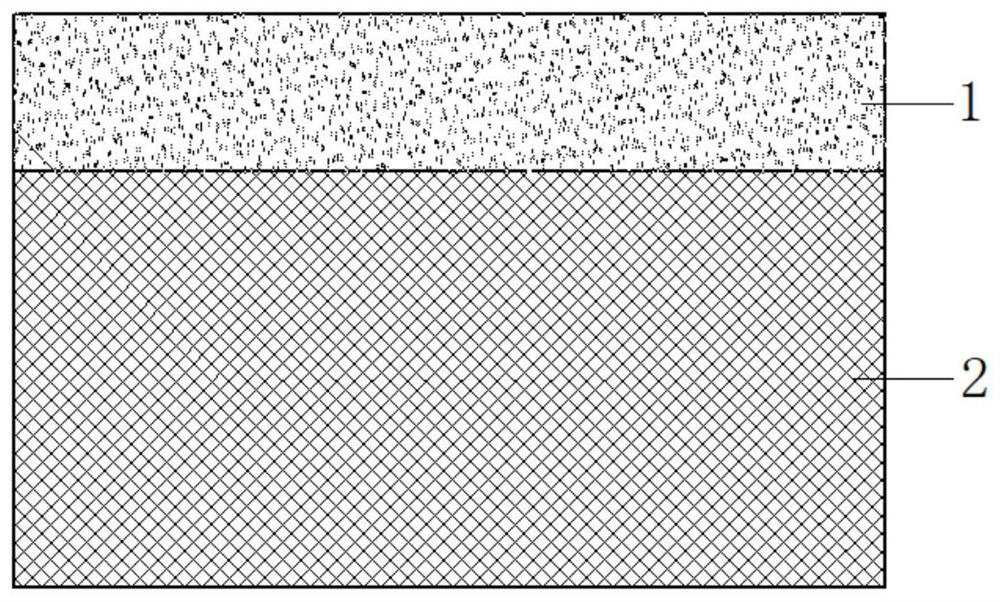A kind of disperse proton conductive ceramic electrolyte film and preparation method thereof
A technology of ceramic electrolyte and proton conduction, which is applied in the direction of circuits, fuel cells, electrical components, etc., can solve problems such as the difficulty in preparing high-performance proton conduction ceramic electrolyte films, and achieve the effects of high density, controllable thickness, and low cost
- Summary
- Abstract
- Description
- Claims
- Application Information
AI Technical Summary
Problems solved by technology
Method used
Image
Examples
Embodiment 1
[0024] (1) ZrO with a length of 60mm, an outer diameter of 15mm and a wall thickness of 2mm 2 Ultrasonic cleaning of ceramic tube surface for 15 minutes, drying;
[0025] (2) Simultaneous deposition of SrCe on the surface of ceramic tubes by metal-organic chemical vapor deposition technology 1-x Yb x o 3-α and SrCe 1-x Er x o 3-α The reaction source uses ytterbium acetylacetonate and erbium acetylacetonate, and the specific process parameters are: Yb reaction source temperature 450°C; Er reaction source temperature 420°C, Yb reaction source reaction time 30min; Er reaction source reaction time 20min, carrier gas H 2 The flow rate is 200mL / min.
[0026] (3) SrCe with a thickness of about 0.5 μm is finally obtained 1-x Yb x o 3-a / SrCe 1-x Er x o 3-α dispersed film, in which the main phase SrCe 1-x Yb x o 3-α The content accounts for about 70%, the film layer is uniform and dense, and has good bonding force with the substrate;
[0027] Determination of SrCe by AC...
Embodiment 2
[0029] (1) ZrO with a length of 60mm, an outer diameter of 15mm and a wall thickness of 2mm 2 Ultrasonic cleaning of ceramic tube surface for 15 minutes, drying;
[0030] (2) Simultaneous deposition of SrCe on the surface of ceramic tubes by metal-organic chemical vapor deposition technology 1-x Yb x o 3-α and SrCe 1-x Er x o 3-α The reaction source adopts ytterbium acetylacetonate and erbium acetylacetonate, and the specific process parameters are: Yb reaction source temperature 350°C; Er reaction source temperature 320°C, Yb reaction source reaction time 30min; Er reaction source reaction time 20min, carrier gas H 2 The flow rate is 100mL / min.
[0031] (3) SrCe with a thickness of about 1.5 μm is finally obtained 1-x Yb x o 3-a / SrCe 1-x Er x o 3-α dispersed film, in which the main phase SrCe 1-x Yb x o 3-α The content accounts for about 70%, the film layer is uniform and dense, and has good bonding force with the substrate;
[0032] Determination of SrCe by ...
Embodiment 3
[0034] (1) ZrO with a length of 60mm, an outer diameter of 15mm and a wall thickness of 2mm 2 Ultrasonic cleaning of ceramic tube surface for 15 minutes, drying;
[0035] (2) Simultaneous deposition of SrCe on the surface of ceramic tubes by metal-organic chemical vapor deposition technology 1-x Yb x o 3-α and SrCe 1-x Er x o 3-α The reaction source uses ytterbium acetylacetonate and erbium acetylacetonate, and the specific process parameters are: Yb reaction source temperature 650°C; Er reaction source temperature 620°C, Yb reaction source reaction time 30min; Er reaction source reaction time 20min, carrier gas H 2 The flow rate is 400mL / min.
[0036] (3) SrCe with a thickness of about 8.5 μm is finally obtained 1-x Yb x o 3-a / SrCe 1-x Er x o 3-α dispersed film, in which the main phase SrCe 1-x Yb x o 3-α The content accounts for about 80%, the film layer is uniform and dense, and has good bonding force with the substrate;
[0037] Determination of SrCe by AC...
PUM
| Property | Measurement | Unit |
|---|---|---|
| thickness | aaaaa | aaaaa |
| thickness | aaaaa | aaaaa |
| thickness | aaaaa | aaaaa |
Abstract
Description
Claims
Application Information
 Login to View More
Login to View More - R&D
- Intellectual Property
- Life Sciences
- Materials
- Tech Scout
- Unparalleled Data Quality
- Higher Quality Content
- 60% Fewer Hallucinations
Browse by: Latest US Patents, China's latest patents, Technical Efficacy Thesaurus, Application Domain, Technology Topic, Popular Technical Reports.
© 2025 PatSnap. All rights reserved.Legal|Privacy policy|Modern Slavery Act Transparency Statement|Sitemap|About US| Contact US: help@patsnap.com

